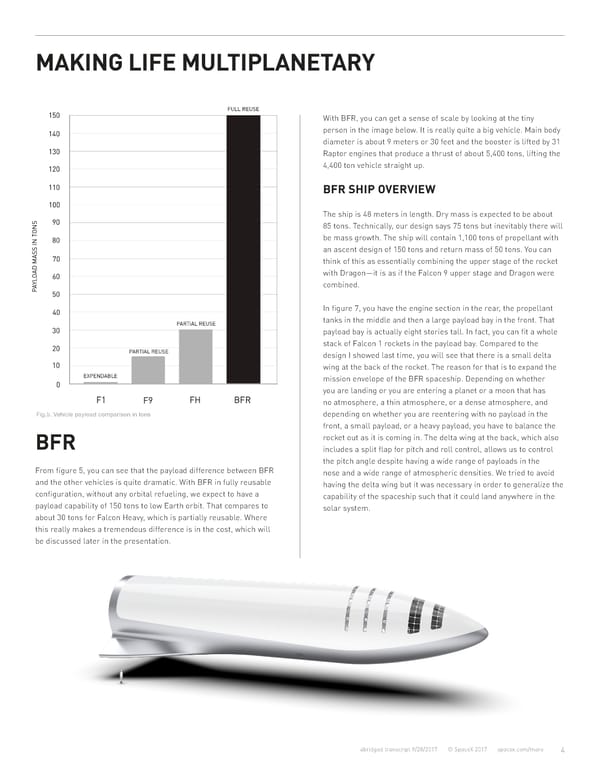MAKING LIFE MULTIPLANETARY With BFR, you can get a sense of scale by looking at the tiny person in the image below. It is really quite a big vehicle. Main body diameter is about 9 meters or 30 feet and the booster is lifted by 31 Raptor engines that produce a thrust of about 5,400 tons, lifting the 4,400 ton vehicle straight up. BFR SHIP OVERVIEW The ship is 48 meters in length. Dry mass is expected to be about 85 tons. Technically, our design says 75 tons but inevitably there will be mass growth. The ship will contain 1,100 tons of propellant with an ascent design of 150 tons and return mass of 50 tons. You can think of this as essentially combining the upper stage of the rocket with Dragon—it is as if the Falcon 9 upper stage and Dragon were combined. In figure 7, you have the engine section in the rear, the propellant tanks in the middle and then a large payload bay in the front. That payload bay is actually eight stories tall. In fact, you can fit a whole stack of Falcon 1 rockets in the payload bay. Compared to the design I showed last time, you will see that there is a small delta wing at the back of the rocket. The reason for that is to expand the mission envelope of the BFR spaceship. Depending on whether you are landing or you are entering a planet or a moon that has no atmosphere, a thin atmosphere, or a dense atmosphere, and Fig.5. Vehicle payload comparison in tons depending on whether you are reentering with no payload in the front, a small payload, or a heavy payload, you have to balance the BFR rocket out as it is coming in. The delta wing at the back, which also includes a split flap for pitch and roll control, allows us to control the pitch angle despite having a wide range of payloads in the From figure 5, you can see that the payload difference between BFR nose and a wide range of atmospheric densities. We tried to avoid and the other vehicles is quite dramatic. With BFR in fully reusable having the delta wing but it was necessary in order to generalize the configuration, without any orbital refueling, we expect to have a capability of the spaceship such that it could land anywhere in the payload capability of 150 tons to low Earth orbit. That compares to solar system. about 30 tons for Falcon Heavy, which is partially reusable. Where this really makes a tremendous difference is in the cost, which will be discussed later in the presentation. abridged transcript 9/28/2017 © SpaceX 2017 spacex.com/mars 4
 Making Life Multiplanetary Page 3 Page 5
Making Life Multiplanetary Page 3 Page 5